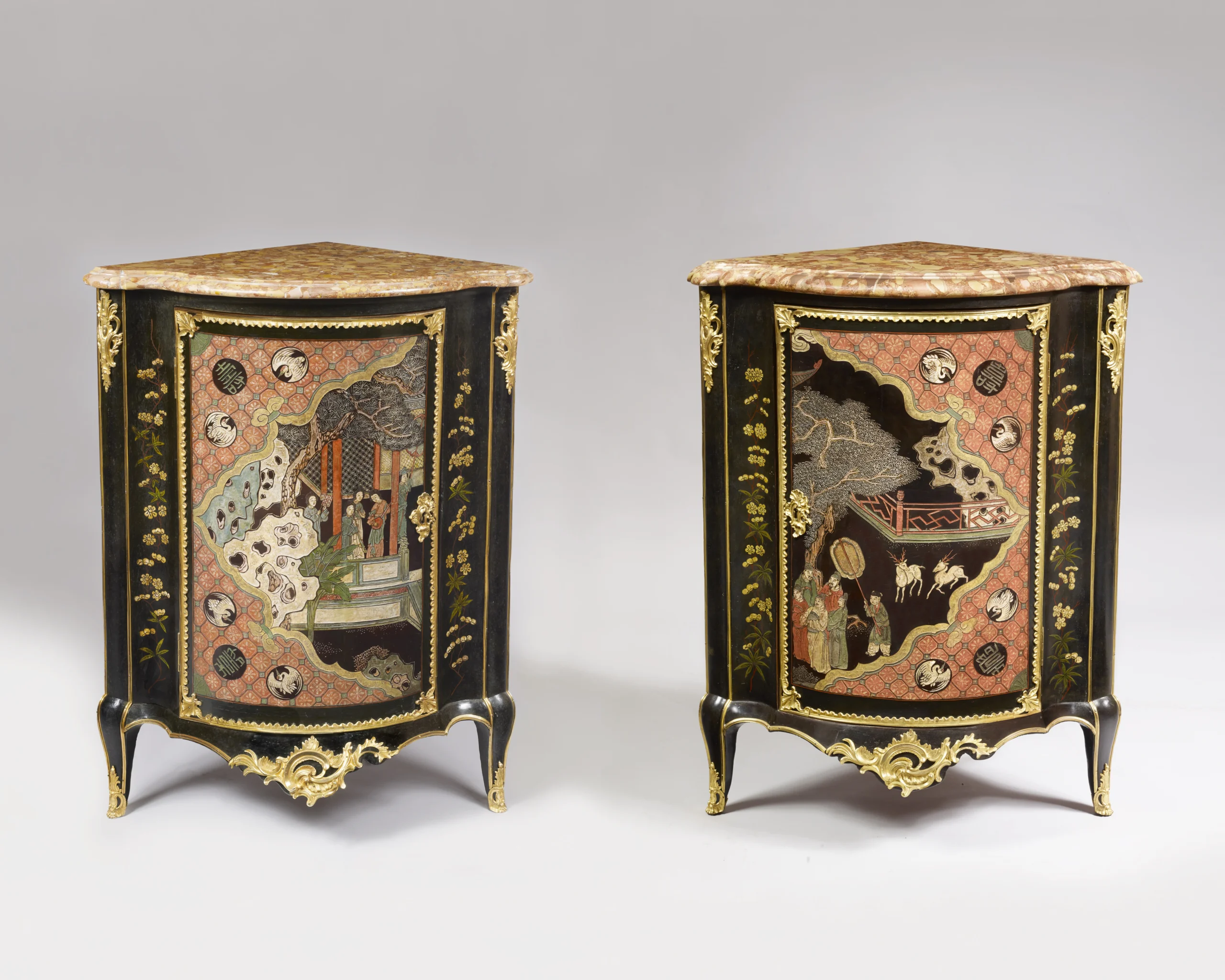France, Louis XV period, mid-18th century
Stamped DELORME
Adrien Faizelot Delorme (1722−1791)
Coromandel lacquer and European varnish, gilt bronze
Aleppo breach marble top
Crowned C marks
Published in:
- Nicole Brugier, Les Laques de Coromandel, Paris, La Bibliothèque des Arts, 2015, p. 190.
Close example:
- Adrien Faizelot Delorme, Chest of drawers, circa 1750, Amsterdam, Rijksmuseum (inv. BK-16652)
These curved corner cupboards are veneered with a Coromandel lacquer panel on the door. The latter presents a tripartite decor. A pink drapery bordered with gold, with motifs of cranes and Chinese characters, adorns the upper and lower right corners of the first corner, and the left of the second. It opens to reveal scenes of palaces and gardens. The lacquer on each of these corners seems to come from the same panel. The doors are framed by curved mounts, in European lacquer with vegetal decoration. The overall ornamentation is raised by finely chased and gilt bronzes: door frame, clogs and apron.
Inside, the door is adorned with a delicate frieze pattern associating light and dark woods.
Coromandel Lacquer
Lacquer furniture represents the enthusiasm for the exoticism during the 18th century. Screens, chests or even more boxes, were imported from Asia and were dissembled to provide ornamentation to the European furniture, such as this pair of corner cupboards.
Passing through the Coromandel Coast, on the eastern Coast of India, the term of Coromandel lacquer is used today to describe what the Chinese call Ke hui literally “incised ash” or Kuan Cai, “carved and colorful lacquer”. These panels have the particularity of being first covered with soft clay layer on which was put a coating of fibrous grasses and canvas covered with lacquer before being carved. Cut-out parts were either gilt or painted with a sand preparation with added pigments.
Adrien Faizelot Delorme (1722−1791)
Adrien Delorme Faizelot became a Master in 1748. Son of the cabinetmaker François Faizelot Delorme (1692−1768), he was early trained to his work. His marriage in 1748 with Catherine Madeleine Duval, widow successively of the cabinetmakers Albert Potier and Pierre Guérard allowed him to get the workshop of the latter, Rue du Temple. Initiated by his father to the Asian lacquers, Adrien also appealed to Martin varnish.
While most cabinetmakers worked with marchands merciers1 who provided their expensive panels in Coromandel lacquer, Adrien Faizelot Delorme was one of the few to have his own.
Meanwhile he produced many furniture with marquetry, using amaranth wood on tulipwood or satiné background. His works close to those of Criaerd, BVRB, Latz or Œben illustrate the moment of perfection during the reign of Louis XV. Recognized by his peers, he was elected juror by his community in 1766. In 1783, he sold his business and retired from the profession.
The C crowned mark
A decree of 1745 made obligation to the bronzers to stamp their works with a small distinctive letter: a C surmounted by a crown, thus submitting them to the rules of paying a tax. It applied “on all works old or new of pure copper, iron, bronze and more, mixed, melted, beaten, forged, planed, engraved, gilt, silvered and put into color without exception.” The 4th of February 1749 a decree of the Council took an end at this obligation which was presumably linked to the end of the War of the Austrian succession which financing was caused by the creation of numerous small taxes.
The text details that it concerns “all work old or new”. It was thus possible to find it on pieces anterior to 1745. For that to happen, it is sufficient that the object was submitted for a new layer of gilding or that it passed in the trade during these four years. That is the case for works of André-Charles Boulle, from the Louis XIV period, but whose success continued far longer.
Bibliography
- Daniel Alcouffe, Yves Carlier, 18e aux sources du design, chefs‑d’œuvre du mobilier 1650–1790, Versailles, Château de Versailles, 2014.
- Nicole Brugier, Les laques de Coromandel, Paris, La Bibliothèque des Arts, 2015, p. 190.
Measurements:
- Height: 95 cm – 37 ½ inches
- Depth: 52 cm – 20 ½ inches
- Width: 73,5 cm – 29 inches
